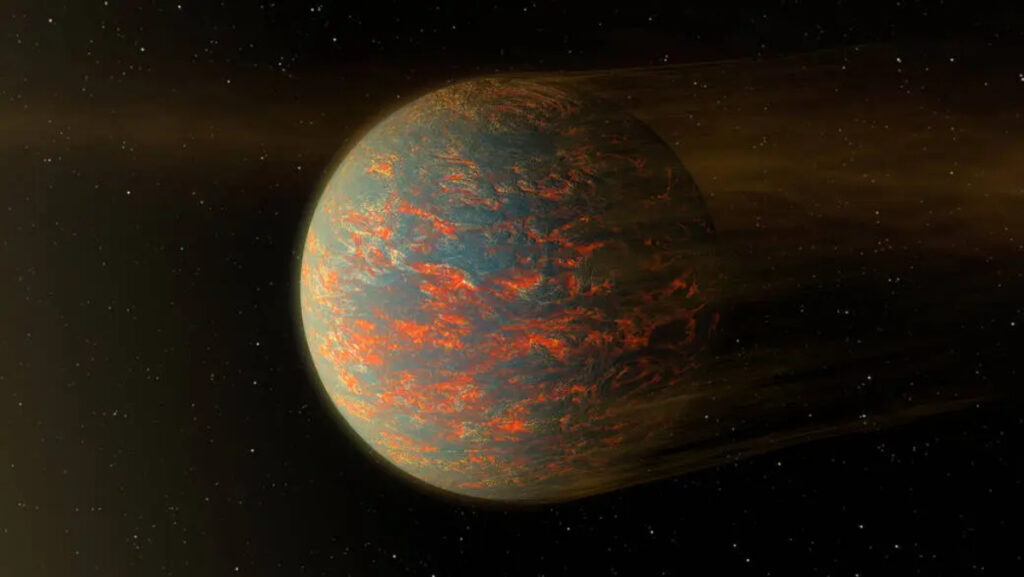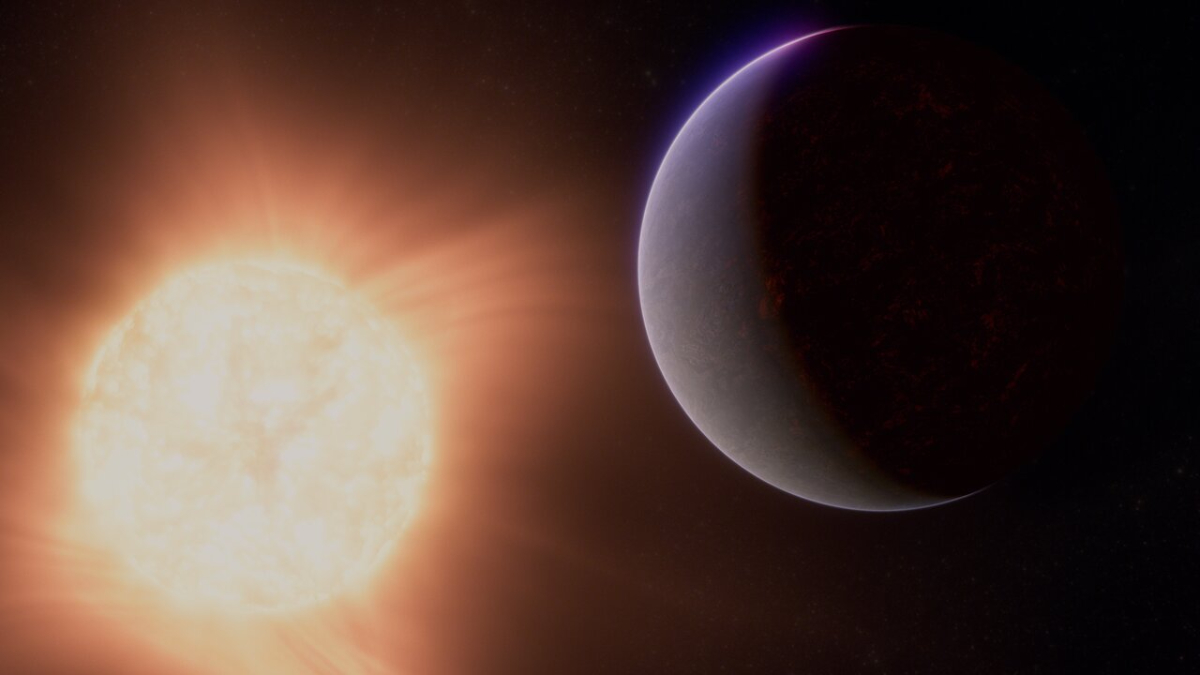For the first time, astronomers have discovered an atmosphere surrounding a rocky exoplanet—but it isn’t the atmosphere that the planet started with. Scientists used the James Webb Space Telescope (JWST) to measure the light emitted by 55 Cancri e, a nearby lava world about twice the size of Earth. The data suggest that the atmosphere is thick and possibly has carbon monoxide (CO) and carbon dioxide (CO2).
“Through observation of this extrasolar example of atmosphere-magma interaction, we can better understand how the early solar system worked,” explained Renyu Hu, a planetary scientist at the California Institute of Technology in Pasadena.
First Super-Earth’s Second Atmosphere
Discovered in 2004, 55 Cancri e is the smallest and innermost of five known planets orbiting a star 41 light-years away. It was the first known super-Earth, or a rocky planet slightly larger than Earth. The planet is inhospitable to life as we know it: It orbits around its star in less than 18 hours and is a scorching 2,000 kelvin (1,727°C).
As the first known super-Earth, 55 Cancri e has been a top target for observations for 2 decades. Past research revealed that its surface is likely covered in lava and it lacks an atmosphere of hydrogen and helium—a so-called primordial atmosphere that the planet would have been born with.

Instead, astronomers have measured large variations in the planet’s emitted heat that could indicate the atmosphere’s chemistry, and thus heat output, changes rapidly. Or they could suggest the planet is a bare rock and the heat variations are from differences in the day- and nightside lava.
Hu and his colleagues wanted to leverage JWST’s powerful infrared capabilities to observe the planet’s emitted heat in more detail and reveal more about its potential atmosphere. The team gathered data from the telescope’s Near-Infrared Camera (NIRCam) and Mid-Infrared Instrument (MIRI) in November 2022 and March 2023, which provided a clear look at the heat emitted by the planet at different infrared wavelengths.
The new data agree that 55 Cancri e’s thermal spectrum doesn’t have any of the emissions features expected of a primordial hydrogen-helium atmosphere. If it ever had one, it was probably quickly blown away by stellar winds.
“The atmosphere is supported by the magma ocean down below.”
The team’s simulations of 55 Cancri e’s atmosphere, which they tested with different chemical combinations, temperatures, and pressures, provided context to the new JWST data. The spectrum doesn’t match what would be expected from an atmosphere of vaporized rock but does suggest that 55 Cancri e could have a thick secondary atmosphere made of CO and CO2 and other volatiles outgassed from the volcanic surface.
“We envision that the atmosphere is supported by the magma ocean down below,” Hu said. “The magma ocean is likely to be a highly dynamic environment, and the interaction between the magma ocean and the atmosphere could result in the composition of the atmosphere changing quite quickly.”
Those interactions could also release rock-forming elements such as sodium, magnesium, and silicon into the atmosphere, which would alter the atmospheric structure and explain the variability of past observations, Hu said. This research was published in Nature.
Beyond the Cosmic Shoreline
“This study convinces me that something interesting is going on on this planet and that repeated observations and analyses are needed,” said Peter Gao, especially because the planet has shown heat variability in the past.
Demystifying 55 Cancri e’s atmosphere could help astronomers understand the “cosmic shoreline” of exoplanets.
Gao, an exoplanetary scientist at the Carnegie Institution for Science in Washington, D.C., who was not involved with the work, said that demystifying 55 Cancri e’s atmosphere could help astronomers understand the “cosmic shoreline” of exoplanets. This concept describes how planets with too much heat or without enough gravity, like Mars, lose their atmospheres too quickly for life to develop.
Confirmation of 55 Cancri e’s secondary atmosphere, Gao said, “would show that there exists an additional ‘shoreline’—the opposite shore, if you will—where at high enough temperatures the surface becomes molten, allowing interior volatiles to outgas onto the surface to form an atmosphere.”
Hu added that both Earth and Venus may have looked like 55 Cancri e a few billion years ago: volatile lava worlds covered by magma oceans that generated outgassed atmospheres. The atmosphere of 55 Cancri e could provide new insight into our solar system’s past and also about other lava worlds that may or may not resemble the first super-Earth.
“I guess we should observe more of them!” Gao said.
—Kimberly M. S. Cartier (@AstroKimCartier), Staff Writer

